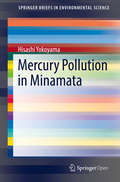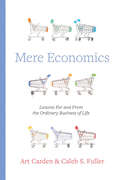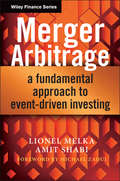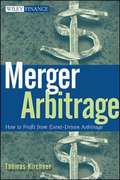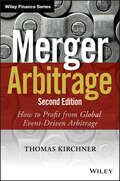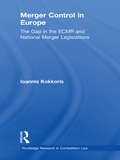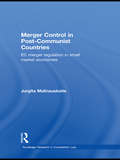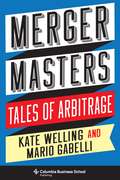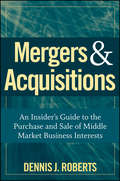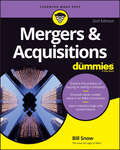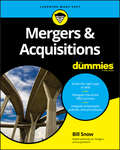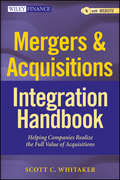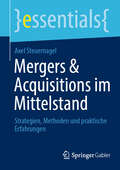- Table View
- List View
Mercury Athletic: Valuing the Opportunity
by Timothy A. Luehrman Joel L. HeilprinIn January 2007, West Coast Fashions, Inc., a large designer and marketer of branded apparel, announced a strategic reorganization that would result in the divestiture of their wholly owned footwear subsidiary, Mercury Athletic. John Liedtke, the head of business development for Active Gear, a mid-sized athletic and casual footwear company, saw the potential acquisition of Mercury as a unique opportunity to roughly double the size of his business. The case uses the potential acquisition of Mercury Athletic as a vehicle to teach students basic DCF (discounted cash flow) valuation using the weighted average cost of capital (WACC).
Mercury Pollution in Minamata (SpringerBriefs in Environmental Science)
by Hisashi YokoyamaThis book is open access under a CC BY 4.0 license. It overviews the poisoning which occurred in the 1950s and 1960s among the residents in Minamata who ate seafood contaminated with methylmercury discharged from the chemical factory, Chisso Corporation. It describes the history, symptoms pathogenesis and research on the causal agent, and discusses the responses of Chisso and the national and local governments to the outbreak, the victims, the compensation and environmental restructuring as well as the court ruling on claims. Based on lecture notes from a university course, it includes students’ suggestions for avoiding a repeat of the tragedy. The issue has not been settled yet, and this analysis of the incident provides useful insights into solutions to the current global mercury pollution problem.
Mercury Rising: Knight Ridder's Digital Venture
by Clark GilbertCaptures the efforts of newspaper publisher Knight Ridder to create a digital venture. Knight Ridder proves to be a pioneer in digital publishing, launching the first online newspaper site; builds a network of newspaper sites called Real Cities; and invests in Careerbuilder, the second largest career site after Monster.com. However, the company has cumulatively lost over $100 million in its core Internet operations, is missing important categories of advertising revenue, and is operating in an ad recession at the time of the case. Tracks the evolution of the venture that spans nearly a decade and can be summarized in three distinct periods: 1) initial launch and experimentation, 2) rapid expansion within the newspaper organization vs. operation as a separate venture, and 3) managing the venture after the Internet bubble has burst.
Mercy Corps: Global Social Entrepreneurship (A)
by Christopher A. Bartlett Daniel F. CurranNeal Keny-Guyer, CEO of Mercy Corps International, built his organization by following the advice of Theodore Roosevelt: "Be smart enough to hire good people and have sense enough to get out of their way." For eight years, Keny-Guyer helped Mercy Corps grow in size and scope and by 2001, delivered $117 million in social programs to people in over 30 countries. Convinced that much of that success had come from empowering front-line managers to lead the agency by pursuing opportunities in the field, he wanted to continue the approach. But, recent experiences in Afghanistan had exposed some weaknesses in Mercy Corps' ability to maintain an entrepreneurial approach in an emergency situation. What had worked so well in an organization of 200 was encountering difficulties now that worldwide staff exceeded 2,000. At a global leadership conference in late October 2002, Keny-Guyer met with his senior leadership team. In addition to wrestling with the political complexities of working in Iraq, he wanted to get their input on how Mercy Corps should respond if they decided it was the right course of action.
Mercy Corps: Positioning the Organization to Reach New Heights
by Caroline King Allen GrossmanMercury Corps, the world's 5th largest international relief and development agency, is at a turning point. The nonprofit's opportunities to grow and serve a larger number of beneficiaries are unprecedented. By looking at the unique relationship between headquarters and over 40 country offices, explores the question--is Mercury Corps well positioned to effectively and efficiently manage these new growth opportunities.
Mercy For Animals: One Man's Quest to Inspire Compassion and Improve the Lives of Farm Animals
by Gene Stone Nathan RunkleA compelling look at animal welfare and factory farming in the United States from Mercy For Animals, the leading international force in preventing cruelty to farmed animals and promoting compassionate food choices and policies. Nathan Runkle would have been a fifth-generation farmer in his small midwestern town. Instead, he founded our nation’s leading nonprofit organization for protecting factory farmed animals. In Mercy For Animals, Nathan brings us into the trenches of his organization’s work; from MFA’s early days in grassroots activism, to dangerous and dramatic experiences doing undercover investigations, to the organization’s current large-scale efforts at making sweeping legislative change to protect factory farmed animals and encourage compassionate food choices.But this isn’t just Nathan’s story. Mercy For Animals examines how our country moved from a network of small, local farms with more than 50 percent of Americans involved in agriculture to a massive coast-to-coast industrial complex controlled by a mere 1 percent of our population—and the consequences of this drastic change on animals as well as our global and local environments. We also learn how MFA strives to protect farmed animals in behind-the-scenes negotiations with companies like Nestlé and other brand names—conglomerates whose policy changes can save countless lives and strengthen our planet. Alongside this unflinching snapshot of our current food system, readers are also offered hope and solutions—big and small—for ending mistreatment of factory farmed animals. From simple diet modifications to a clear explanation of how to contact corporations and legislators efficiently, Mercy For Animals proves that you don’t have to be a hardcore vegan or an animal-rights activist to make a powerful difference in the lives of animals.
Mere Economics
by Art Carden Caleb S. FullerWhen one hears the word "economics," it is easy to conjure up images of charts, graphs, and spreadsheets. One might think of traders, clamoring to buy and sell various stocks from companies that the normal man has never even heard of or seen. Or, more likely, they might think of accountants, crunching away numbers in a cubicle, trying to balance budgets. This, however, is not the reality for Art Carden and Caleb Fuller. In their book, Mere Economics, these professors do more than simply discuss the realities of economic theory. They highlight the reality that there is a Christian case for one's involvement in the economy. Mere Economics points to the basic principles of economic theory with a tone that is conversational and inviting, with the hope that the everyday Christian will not only discover helpful insight into the world of economics, but will find within it the call for responsibility and stewardship.
Merger Arbitrage
by Lionel Melka Amit ShabiA wave of corporate mergers, acquisitions, restructuring, and similar transactions has created unprecedented opportunities for those versed in contemporary risk arbitrage techniques. At the same time, the nature of the merger wave has lent such transactions a much higher degree of predictability than ever before, making risk arbitrage more attractive to investors. Surprisingly, there is little transparency and instruction for investors interested in learning the latest risk arbitrage techniques. Merger Arbitrage - A Fundamental Approach to Event-Driven Investing helps readers understand the inner workings of the strategy and hedge funds which engaged in this investment strategy.Merger arbitrage is one of the most commonly used strategies but paradoxically one of the least known. This book puts it in the spotlight and explains how fund managers are able to benefit from mergers and acquisitions. It describes how to implement this strategy, located at the crossroad of corporate finance and asset management, and where its risks lie through numerous topical examples.The book is split into three parts. The first part, examining the basis of merger arbitrage, looks at the key role of the market in takeover bids. It also assesses the major changes in the financial markets over recent years and their impact on M&A. Various M&A risk and return factors are also discussed, alongside the historical profitability of merger arbitrage, the different approaches used by fund managers and the results of academic studies on the subject. The second part of the book deals with the risk of an M&A transaction failing in terms of financing risk, competition issues, the legal aspects of merger agreements and administrative and political risks. The third part of the book examines specificities of M&A transactions, comprehensively covering hostile takeovers and leveraged buyouts. Each part contains many recent examples and case studies in order to show how the various theories and notions are put into practice.From researching prospects and determining positions, to hedging and trading tactics, Lionel Melka and Amit Shabi present the full complement of sophisticated risk arbitrage techniques, making Merger Arbitrage a must read for finance and investment professionals who want to take advantage of the nearly limitless opportunities afforded by today's rapidly changing global business environment. The book builds on its authors' diverse backgrounds and common experience managing a merger arbitrage fund, providing readers with an enriching inside view on M&A operations.
Merger Arbitrage
by Thomas KirchnerA detailed look at an important hedge fund strategy Written by a fund manager who invests solely in merger arbitrage, also referred to as risk arbitrage, and other event-driven strategies, Merger Arbitrage is the definitive book on how this alternative hedge fund strategy works. Initial chapters are dedicated to the ins and outs of the strategy-cash mergers versus stock for stock mergers, legal aspects of mergers, and pitfalls of the merger process-while later chapters focus on giving the reader sound advice for integrating merger arbitrage into an investment portfolio. Merger Arbitrage helps readers understand leverage and options, shorting stocks, and legal aspects of merger arbitrage, including seeking appraisal or filing lawsuits for inadequate merger consideration. For those looking to gain an edge in the merger arbitrage arena, this book has everything they need to succeed. Thomas F. Kirchner, CFA (New York, NY), is the founder and portfolio manager of Pennsylvania Avenue Funds (www. pennavefunds. com), which invests in merger arbitrage and other event-driven strategies.
Merger Arbitrage: How to Profit from Global Event-Driven Arbitrage
by Thomas KirchnerMitigate risk and increase returns with an alternative hedge fund strategy Merger Arbitrage: How to Profit from Event-Driven Arbitrage, Second Edition is the definitive guide to the ins and outs of the burgeoning merger arbitrage hedge fund strategy, with real-world examples that illustrate how mergers work and how to take advantage of them. Author Thomas Kirchner, founder of the Pennsylvania Avenue Event-Driven Fund, discusses the factors that drove him to invest solely in merger arbitrage and other event-driven strategies, and details the methods used to incorporate merger arbitrage into traditional investment strategies. And while there is always a risk that a deal will fall through, the book explains how minimal such risks really are when the potential upside is factored in. Early chapters of the book focus on the basics of the merger arbitrage strategy, including an examination of mergers and the incorporation of risk into the arbitrage decision. Following chapters detail deal structures, financing, and legal aspects to provide the type of in-depth knowledge required to execute an effective investment strategy. The updated second edition stresses new, increasingly relevant information like: Worldwide legal deal regimes UK takeover code UK takeover code global offspring Regulators around the world The book provides clear, concise guidance on critical considerations including leverage and options, shorting stocks, and legal recourse for inadequate merger consideration, allowing readers to feel confident about trying a new investment strategy. With simple benefits including diversification of risk and return streams, this alternative hedge fund strategy has a place in even the most traditional plan. Merger Arbitrage: How to Profit from Event-Driven Arbitrage, Second Edition provides the information that gives investors an edge in the merger arbitrage arena.
Merger Control Worldwide
by Maher M. Dabbah K. P. E. Lasok QCMerger Control Worldwide is a comprehensive, multi-contributor collection which sets out the details of every jurisdiction where a mechanism for merger control is in place. A concise, practical account is given of the relevant law in each jurisdiction, presented with the aid of flowcharts and diagrams. Merger Control Worldwide aims to provide the legal community, in particular law firms and policy-makers, with a clear point of reference that will prove invaluable when making decisions and delivering sound and accurate advice in merger cases. This, the first supplement to Merger Control Worldwide, provides an update on developments that have occurred recently in the field. It includes a comprehensive appraisal of two new jurisdictions, Korea and Mexico.
Merger Control in Europe: The Gap in the ECMR and National Merger Legislations (Routledge Research in Competition Law)
by Ioannis KokkorisThis book addresses the phenomenon of mergers that may result in non-coordinated effects in oligopolistic markets. Such cases are sometimes referred to as "non-collusive oligopolies", or "gap cases" and there is a concern that they might not be covered by the substantive test that some Member States use for merger assessment. Ioannis Kokkoris examines the argument that the European Community Merger Regulation (Regulation 4064/89) did not capture gap cases and considers the extent to which the revised substantive test in Regulation 139/2004 deals with the problem of non-collusive oligopolies. The author identifies actual examples of mergers that gave rise to a problem of non-coordinated effects in oligopolistic markets, both in the EU and in other jurisdictions, and analyses the way in which these cases were dealt with in practice. The book considers legal systems such as United Kingdom, United States, Australia and New Zealand. The book investigates whether there is any difference in the assessment of non-collusive oligopolies between the various substantive tests which have been adopted for merger assessment in various jurisdictions. The book also looks at the various methodological tools available to assist competition authorities and the professional advisers of merging firms to identify whether a particular merger might give rise to anticompetitive effects and explores the type of market structure in which a merger is likely to lead to non-coordinated effects in oligopolistic markets.
Merger Control in Post-Communist Countries: EC Merger Regulation in Small Market Economies (Routledge Research in Competition Law)
by Jurgita MalinauskaiteThis book provides a critical analysis of merger control regimes in the former socialist countries with small market economies, looking at the unique challenges facing these economies. Questions will be asked as to what extent these countries have had to follow dictation from the EU and whether this implementation of EU merger control rules has been justified from the point of view of these countries' economic situations. The book will analyse the merger control regimes in Estonia, Latvia and Lithuania, Slovenia and Slovakia. However, reference will be made to other small market economies of the EU including Cyprus, Ireland, Luxembourg and Malta in order to evaluate the particular difficulties the former socialist countries with small market economies have had in the implementation and further development of merger control rules.
Merger Integration at Bank of America: The TrustWeb Project
by Gary P. Pisano Bradley R. StaatsThis case explores project management in a large organization through the eyes of a young project manager, Mike Morris. Morris is tasked with leading a project within the overall merger integration effort at Bank of America. Morris encounters difficulties with managing stakeholders, setting requirements, and reporting progress.
Merger Masters: Tales of Arbitrage (Heilbrunn Center for Graham & Dodd Investing Series)
by Kate Welling Mario GabelliMerger Masters presents revealing profiles of monumentally successful merger investors based on exclusive interviews with some of the greatest minds to practice the art of arbitrage. Michael Price, John Paulson, Paul Singer, and others offer practical perspectives on how their backgrounds in the risk-conscious world of merger arbitrage helped them make their biggest deals. They share their insights on the discipline that underlies their fortunes, whether they practice the “plain vanilla” strategy of announced deals, the aggressive strategy of activist investment, or any strategy in between on the risk spectrum.Merger Masters delves into the human side of risk arbitrage, exploring how top practitioners deal with the behavioral aspects of generating consistent profits from risk arbitrage. The book also includes perspectives from the other side of the mergers and acquisitions divide in the form of interviews with a trio of iconic CEOs: Bill Stiritz, Peter McCausland, and Paul Montrone. All three took advantage of M&A opportunities to help build long-term returns but often found themselves at odds with the short-term focus of Wall Street and merger investors. Told in lively, accessible prose, with bonus facts and figures for transaction junkies, Merger Masters is an incomparable set of stories with plenty of unfiltered lessons from the best managers of our time.
Merger of Equals: The Integration of Mellon Financial and The Bank of New York (A)
by David Lane Clayton Rose Ryan D. TaliaferroLess than a month after the close of the merger between The Bank of New York and Mellon Financial, managers at the two firms realized that plans for combining their asset servicing businesses - and realizing the $180 million of annual cost savings that they had promised Wall Street - were fraught with risk. Senior executives must evaluate the seriousness of the risks and identify alternative ways of integrating the two firms, while safeguarding the technologies that process and clear a substantial fraction of the world's financial transactions. [Continues with "B" and "C" cases.]
Mergers & Acquisitions
by Dennis J. RobertsThis book was designed not only for owners and managers of middle market businesses but as a training text for middle market M&A investment bankers and consultants. It discusses the art and science of middle market M&A as well the all-important psychology and behind-the-scenes negotiations pursued with a particular emphasis on obtaining the absolute highest value when selling a business. Subjects addressed include valuation, taxation, negotiations, M&A conventions, among many others from the buy-side and sell-side perspectives.Subtitled "Tales of A Deal Junkie," this serious but occasionally irreverent book tells it like it is, including anecdotes to provide a "feel" for what really goes on in middle market transactions. The author, a former practicing CPA and a business valuation expert, is a veteran M&A investment banker with years of real life experience. He also is a widely-acclaimed instructor in the M&A field and a nationally-respected practitioner who has trained thousands of investment bankers. No comparable book on the market today provides this degree of comprehensive and invaluable insight.
Mergers & Acquisitions For Dummies
by Bill R. SnowExplore M&As, in simple terms Mergers & Acquisitions For Dummies gives you useful techniques and real-world advice for making these business transactions a success, going beyond case studies to include international laws and regulations, environmental issues, and—most importantly—practical instructions you can really use. In plain English terms that anyone can understand, this book discusses the entire M&A process, including different types of transactions and structures, raising funds, partnering, identifying targets, business valuation, doing due diligence, closing the purchase agreement, and integrating new employees and new ways of doing business. If you’re getting involved in a merger with, or acquisition of, another company, read this book to gain a thorough understanding of what the heck is going on. Updated with deep dives into valuations, environmental issues, negotiating tips, and beyond. Walk through the merger and acquisition process in practical terms Learn the requirements and best practices you’ll need to follow Hire the people who will help you through any M&A scenario Conduct win-win negotiations and get the most out of M&AsMergers & Acquisitions For Dummies is a great choice for business owners and investors who need more information on the process and steps involved in successful M&A transactions.
Mergers & Acquisitions For Dummies
by Bill SnowMergers & Acquisitions For Dummies (9781119543862) was previously published as Mergers & Acquisitions For Dummies (9780470385562). While this version features a new Dummies cover and design, the content is the same as the prior release and should not be considered a new or updated product. The easy way to make smart business transactions Are you a business owner, investor, venture capitalist, or member of a private equity firm looking to grow your business by getting involved in a merger with, or acquisition of, another company? Are you looking for a plain-English guide to how mergers and acquisitions can affect your investments? Look no further. Mergers & Acquisitions For Dummies explains the entire process step by step—from the different types of transactions and structures to raising funds and partnering. Plus, you'll get expert advice on identifying targets, business valuation, doing due diligence, closing the purchase agreement, and integrating new employees and new ways of doing business. Step-by-step techniques and real-world advice for making successful mergers and acquisitions Covers international laws and regulations How to take advantage of high-value deals Going beyond the case studies of other books, Mergers & Acquisitions For Dummies is your one-stop reference for making business growth a success.
Mergers & Acquisitions Integration Handbook
by Scott C. WhitakerProven strategies and tactics to manage the integration of acquired and/or merged companies Mergers & Acquisitions Integration Handbook is a comprehensive resource to help companies create a scalable post merger or acquisition integration process and framework that accelerates operating and business benefit goal realization. Includes tools, templates, forms, examples and checklists to provide a no nonsense "handbook" style approach to managing an effective integration. Helps integration managers quickly get up to speed on various integration challenges, including guidance on developing detailed operational and functional integration plans to support flawless execution. Reveals how to avoid integration failure by establishing an in-house integration management office to handle integration projects. Includes a sample integration playbook that can be used to create a core competency within companies to support ongoing integration activity. Botched integration is the number one reason mergers fail. Mergers & Acquisitions Integration Handbook shows you how to develop, execute and implement merger integrations and business strategies to realize your organization's mergers and acquisitions goals.
Mergers & Acquisitions im Mittelstand: Strategien, Methoden und praktische Erfahrungen (essentials)
by Axel SteuernagelDas Buch bietet eine Einführung und ist zugleich ein praktisches Nachschlagewerk für die Planung und erfolgreiche Durchführung von Unternehmenskäufen und -verkäufen im Mittelstand, sog. Mergers & Acquisitions (M&A).Der Autor zeigt zunächst Gründe auf, warum sich mittelständische Unternehmer mit M&A Transaktionen beschäftigen sollten, als Käufer oder Verkäufer. Neben praktischen Hinweisen für strategische Überlegungen vor dem Start von M&A Aktivitäten gibt er einen detaillierten Überblick über einen typischen M&A Prozess bei Käufen und Verkäufen mittelständischer Unternehmen. Relevante Phasen und Begriffe werden anschaulich erklärt sowie erfahrungsbasierte und pragmatische Hinweise zur Verbesserung der Erfolgschancen gegeben. Darauf aufbauend, erläutert der Autor, wie eine erfolgreiche Integration eines mittelständischen Unternehmens erfolgen kann. Eine Zusammenfassung der wesentlichen Erfolgsfaktoren für M&A im Mittelstand schließt dieses an Unternehmer und unternehmerisch agierende Manager gerichtete Buch ab.

